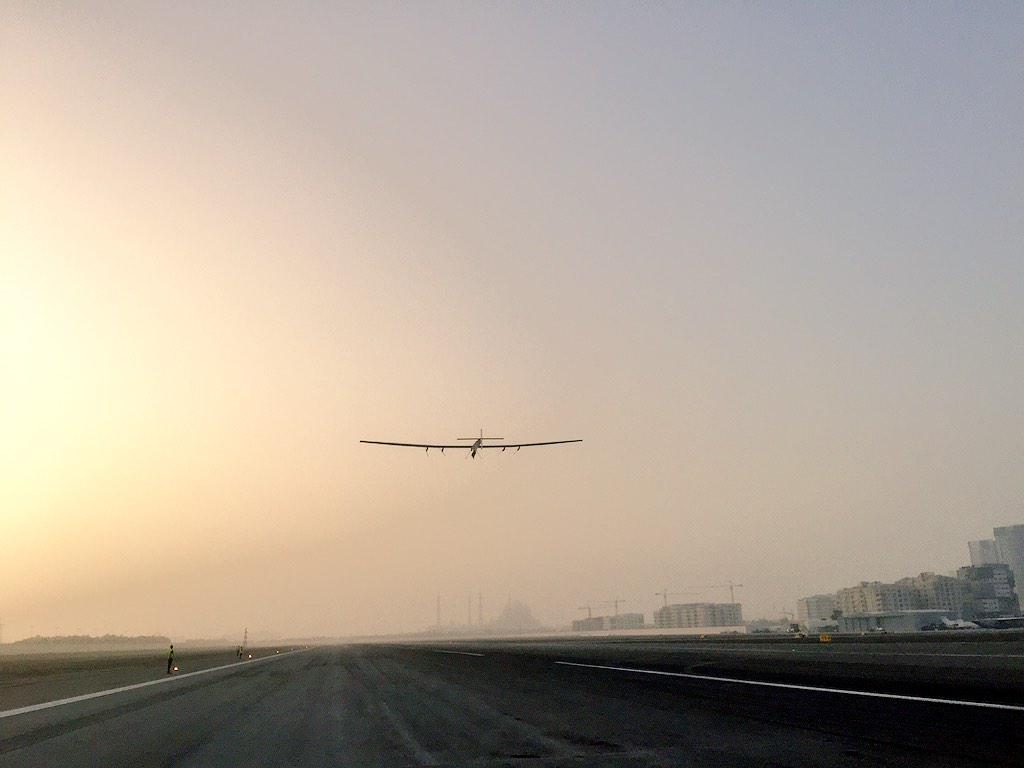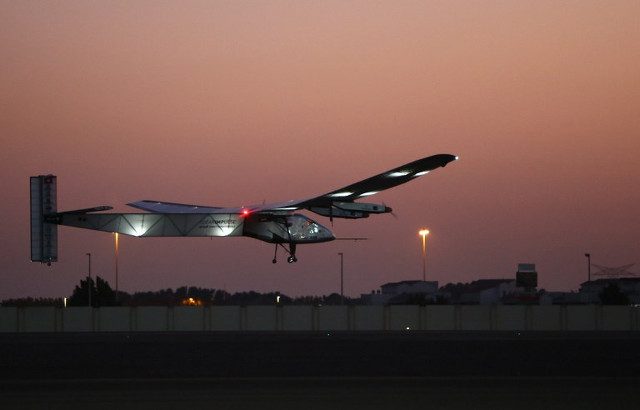SUMMARY
This is AI generated summarization, which may have errors. For context, always refer to the full article.

ABU DHABI, United Arab Emirates (2nd UPDATE) – The first attempt to fly around the world in a plane using solar energy was launched Monday, March 9, in Abu Dhabi, in a landmark journey aimed at promoting green energy.
The Solar Impulse 2, piloted by Andre Borschberg of Switzerland, took off at 7:12 am (0412 GMT) from Al-Bateen airport and headed to Muscat, the capital of Oman, where it is expected to land later Monday after the first leg of the journey, an Agence France-Presse journalist at the launch site said.
The takeoff of Solar Impulse 2, which was delayed on Saturday, March 7, due to high winds, caps 13 years of research and testing by Swiss pilots Andre Borschberg and Bertrand Piccard.
“This project is a human project, it is a human challenge,” Borschberg, co-founder and chief executive of Solar Impulse who will fly the plane on the first leg, told reporters on Sunday, March 8.
The wingspan of the one-seater plane, known as the Si2, is slightly bigger than that of a jumbo jet, but its weight is around that of a family car.
From Muscat, it will make 12 stops on an epic journey spread over 5 months, with a total flight time of around 25 days.
It will cross the Arabian Sea to India before heading on to Myanmar, China, Hawaii and New York.
Landings are also earmarked for the midwestern United States and either southern Europe or North Africa, depending on weather conditions.
The longest single leg will see a lone pilot fly non-stop for 5 days across the Pacific Ocean between Nanjing, China and Hawaii, a distance of 8,500 kilometers (5,270 miles).
Borschberg and Piccard will alternate turns at the controls because the plane can hold only one person.
All this will happen without burning a drop of fuel.
“We want to share our vision of a clean future,” said Piccard, chairman of Solar Impulse.
“Climate change is a fantastic opportunity to bring in the market new green technologies that save energy, save natural resources of our planet, make profit, create jobs, and sustain growth.”
The pilots’ idea was ridiculed by the aviation industry when it was first unveiled.
But Piccard, who hails from a family of scientist-adventurers and was the first person, in 1999, to circumnavigate the globe in a hot air balloon, clung to his belief that clean technology and renewable energy “can achieve the impossible.”
The plane is powered by more than 17,000 solar cells built into wings that, at 72 metres (236 feet), are longer than a jumbo and approaching that of an Airbus A380 superjumbo.
Clean energy petition
Thanks to an innovative design, the lightweight carbon fiber aircraft weighs only 2.3 tonnes, about the same as a family 4X4 and less than one percent of the weight of the A380.
The Si2 is the first solar-powered aircraft able to stay aloft for several days and nights.

The propellor craft has 4 17.5 horsepower electric motors with rechargeable lithium batteries.
It will travel at 50-100 kilometers per hour, with the slower speeds at night to prevent the batteries from draining too quickly.
The Si2 is the successor to Solar Impulse, a smaller craft that notched up a 26-hour flight in 2010, proving its ability to store enough power in the batteries during the day to keep flying at night
It made its last successful test flight in the United Arab Emirates on March 2, and mission chiefs reported no problems.
It is scheduled to arrive back in Abu Dhabi in July, flown by Piccard.
For him, “the project should not finish in July, it should start in July.” A petition was launched on futureisclean.org to campaign in favor of clean energy.
The pilots will be linked to a control center in Monaco where 65 weathermen, air traffic controllers and engineers will be stationed. A team of 65 support staff will travel with the two pilots.
Its progress can be monitored via live video streaming at www.solarimpulse.com. – Wissam Keyrouz, AFP/Rappler.com
Add a comment
How does this make you feel?
There are no comments yet. Add your comment to start the conversation.